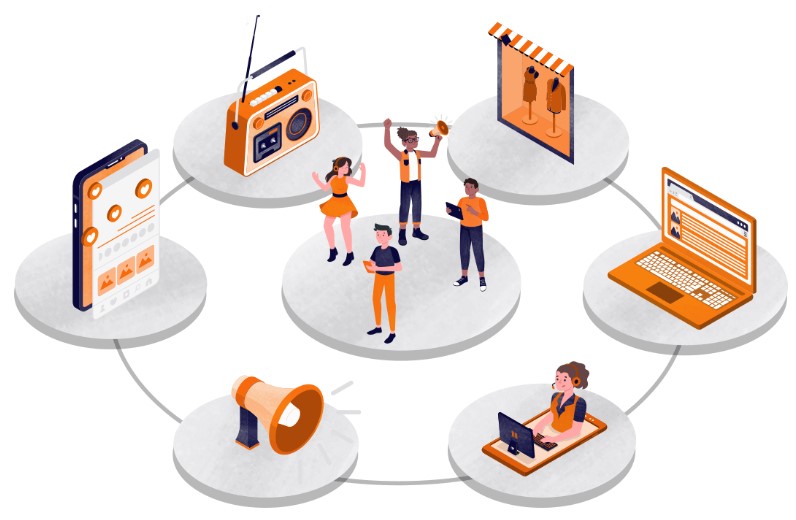Multichannel Introduction What you need to know
The goal of every company is to reach many customers through various channels and achieve high customer satisfaction. This will make it easier for you to get high sales turnover opportunities.
One strategy or way to reach a large number of customers simultaneously through various channels with a high level of customer satisfaction is to use an omnichannel strategy.
What is omnichannel? What are its advantages and how does it work? Please read this article till the end to find out. Read more!
What is omnichannel?
Omnichannel is a system that integrates various types of communication channels into one platform. The main goal of an omnichannel strategy is to improve customer experience by optimizing the use of various available communication media channels.
Omnichannel comes from two words: Omni and Channel. Omni means everything, universal. While the channel is a channel. This means combining all channels (channels/media) so that customers can find and connect with your company through various channels, such as multi-channel, but providing a better customer experience and a higher level.
Multichannel is the next step in the evolution of omnichannel, a broader step that provides real-time updates to users (end users). It combines the most relevant communication channels for your customers together. Rather than working in tandem, communication channels and supporting resources are designed to work together.
What are the types of omnichannel?
Omnichannel types fall into three categories: social media omnichannel, ecommerce omnichannel, and contact center omnichannel. Below is an explanation of each.
1. Multi-channel social media
Multi-channel social media means using social media channels as part of your business approach. In this case, the company ensures that it can serve its customers quickly on various social media platforms such as WhatsApp. Facebook, Instagram, Twitter, Line, Telegram.
2. Multi-channel e-commerce
Multi-channel e-commerce is an e-commerce system that uses a comprehensive approach to selling products and services to customers. This system can provide services through various e-commerce services.
3. Multi-channel contact center
Lastly, omnichannel contact center. This is a telephone service center that uses a multi-channel approach to serve its customers. This system allows you to record all conversations between agents and customers. So, you can rate us to provide you with better service.
What are the benefits of omnichannel?
The benefits of omnichannel make it easier for customers to shop, access the product information they need on one page, and make it easier for your company to interact with customers.
There are also several benefits to using an omnichannel strategy:
1. Increase customer reach
Leveraging different channels and platforms will make it easier for you to reach potential customers. You can also attract and retain a wider customer base by providing consistency and easy access across all channels. This helps increase market share and grow your business. This system makes it easy for employees to reach multiple customers at once.
2. Increased customer satisfaction
This system allows customers to choose the channel that best suits their preferences and needs. Customer information is also integrated across channels. This allows your company to provide a personalized and relevant experience. By providing easy access and responsive service, you can increase customer satisfaction, build loyalty, and improve customer retention. This not only helps you retain existing customers and attract new ones, but also build long-term, mutually beneficial customer relationships.
3. Increase customer references
Now you know that this system can help you increase customer satisfaction. Your company has moved to a higher level to achieve increased sales. This is also related to the fact that if many customers are satisfied, then the company’s brand will increase significantly. From there you can get many other customers. Satisfied customers will recommend your company to their colleagues. So, you have a greater chance of getting customers.
4. Increased work efficiency
By consolidating all communication channels – phone, email, social media – into one central platform, your team can easily track and respond to customer requests quickly and efficiently. This helps prevent lost information or interrupted responses that can reduce productivity.
Additionally, by unifying customer data across channels, your team can better understand customer preferences and purchase history. This allows the team to provide more personalized service.
How does omnichannel work?
How does omnichannel work? It means combining all of your company’s channels into one centralized platform, ensuring nothing gets missed and all questions are answered consistently. This allows your employees to effectively answer all customer questions across multiple channels.
Compare the differences between two companies A and B. Company A uses omnichannel for its business. This application allows business staff to respond to customers quickly. Customer messages are distributed evenly. So no employee is working beyond their capacity.
This allows your staff to answer all customer questions through various communication channels. What is the result? It is undeniable that Company A’s customer satisfaction level is very high.
On the other hand, Company B does not use omnichannel. However, they follow the same social media developments as Company A. As a result, Company B employees have to open business accounts one by one through different communication channels. Don’t ask me whether this is a hassle or not. Of course it is annoying. Especially if you have a lot of incoming messages.
As a result, Company B’s customers feel that Company B’s employees are unresponsive. In fact, the company’s employees do their best to answer customer questions.
So, which company do you prefer? Obviously, Company A has a better system to improve work efficiency.
At first glance, the way it works is similar to omnichannel, which uses various media to capture and interact with customers. However, in this system, all communication channels can be integrated with each other. You cannot integrate multiple channels simultaneously.
What is the difference between omnichannel and multichannel?
The main difference between omnichannel and omnichannel is focus. Omnichannel is more customer-oriented, aiming to provide a unified and consistent experience, while omnichannel focuses more on product availability across multiple channels.
Omnichannel puts the customer at the center with the goal of providing a consistent and unified experience across all communication channels. It allows customers to interact with agents without interruption and have a good experience. Omnichannel, on the other hand, focuses more on product availability across multiple channels. An omnichannel focus means product availability is a priority and customers can often find differences in pricing or offers across channels.
What makes an omnichannel strategy good for your business?
A good omnichannel strategy in business involves integrating multiple channels of communication and customer interaction. First, customer data must be collected and centralized so that it can be accessed simultaneously across channels. By providing consistent visibility into customer preferences, purchase history, and behavior across channels, businesses can deliver personalized and relevant experiences.
Next, it’s important to provide continuity in the customer journey. This means customers can move from one channel to another without any friction or loss of information. For example, if a customer starts researching a product on your website and then wants to continue to make a purchase in a physical store, you need to integrate their data and preferences to ensure the experience continues without any hassle.
Another strategy you can use is a multichannel marketing strategy. Multichannel marketing is a strategic approach that is implemented through consistency and coordination, especially in interactions with customers and prospects.
In this strategy, companies can use multiple channels to communicate and engage with customers. For example, marketing campaigns can be done through email, text messages, social media, or advertising. It is important to keep your messages and offers consistent across all channels so that your customers feel continuity from one channel to the next. Additionally, integrated customer data allows businesses to send relevant and personalized messages to customers based on their preferences and history.
So what are the benefits for sellers?
For online store owners, omnichannel allows entrepreneurs to immediately know what products their customers will buy. Store owners can also study the activities that buyers do before visiting the store and making purchasing decisions. In this case, customer data can be collected from the store owner.
In addition, this strategy can integrate communication services into one platform. So, if a customer comes to you with a question or complaint, you can get a quick response without having to manually open the business account application.
How to improve your omnichannel strategy?
Integrating an omnichannel strategy with a customer relationship management (CRM) system opens up opportunities for businesses to improve customer interaction management and marketing effectiveness. First, integrating customer data from multiple channels into a customer relationship management (CRM) system gives businesses a consistent view of customer interaction history. This allows your team to understand customer preferences and behaviors and design more targeted and personalized marketing strategies to deliver better experiences.
This integration also allows you to better monitor customer service performance. By connecting customer service data with CRM systems, executives can more efficiently understand and resolve problem responses. Monitor customer satisfaction levels and identify opportunities to improve service quality. Integration with sales data also allows for in-depth analysis of sales performance across channels, allowing companies to measure the effectiveness of their marketing strategies and make adjustments as needed.
Finally, the use of integrated CRM information can be applied to personalized marketing. Businesses can design more effective marketing campaigns by tailoring specific offers based on customer preferences and recorded behavior. With a deeper understanding of customers and overall business performance, companies can improve their marketing and customer service strategies for long-term success. Omnichannel and CRM integration is not just about responding faster to customer inquiries, but also about taking business management to the next level with standardized and measurable information.
Choose an omnichannel system that integrates with your CRM. CRM technology has helped thousands of businesses improve HR performance, increase revenue, improve productivity, and enhance customer service.
As a CRM expert and SEO content writer, I create engaging content that strengthens your brand identity and drives engagement, leveraging my experience to connect with your audience and increase conversion rates.











